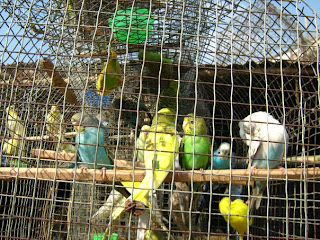 | |
| sailing down the river |
The fair sees much more than the
regular rural livestock trade in cattle, horses, camels and sheep. The range of
animals includes rare bred dogs, elephants, cats, monkeys and rabbits. And if
Alsatians and Terriers weren’t enough for those fond of domestic animals, then
there is a large variety of birds, some even as rare as the Snow Partridge that
is usually found in much colder climate and the Grey-headed Parrot from the
hills near Darjeeling, which are lined up for sale. The ways in which this
annual fair links itself to a number of interconnected networks of trade in the
local region as well as the other parts of the world is hard to imagine. A
simple tabulation of different kinds of animals and goods that are bought and
sold at Sonepur, both legally and illegally is a massive and daunting task. In
terms of illegal trade, snakes, bears and intoxicants of a large variety are
easy answers but on digging deeper, there are a lot of stories left to tell
about Sonepur’s thriving trade environment.
Sonepur, by itself, is a largely unassuming city. One could
get by without much effort while being quite taken by some of its
singularities. The old Gandak Railway Bridge is one such example – more than
two thousand feet long and completed in 1887 during some of the river’s furious
years. With the regular floods in Bihar during the last years of the nineteenth
century and the successive floods in the last few decades, Sonepur’s culture
and social life has survived just like its famous landmark. The first railway
platform at the Sonepur railway station is another such marker to anyone
stepping foot in the city. Far longer than the more famous bridge, this
platform is one of the longest in the world, stretching to more than two
thousand four hundred feet. But these dimensions slowly seem to cease as the
fair makes claim to the pulse of Sonepur’s life.
 |
| Celebrations during Kartik Purnima |
The first day also marks the
worship at the Harihar Nath temple, which is the epicentre of activity on that
day. Offerings and ablutions are part of the rituals and needless to say, there
is a fair bit of waste that accumulates around the fair. While public toilets
are scant, relief mostly presents itself in the proximity between the mango
groves where the fair is held and the tourist accommodation. The routes are
lined with regular forms of entertainment – fortune tellers, soothsayers and those
trained in various human feats like trapeze art or the more spectacular acts
like walking on burning coal.
 |
| An all-male crowd watches a dance show in progress |
Additionally, while trade in
endangered birds and animals is otherwise illegal, it is a flourishing activity
in the backdrop of this popular fair. The district administration takes many
measures to clean up the negative publicity that the Sonepur fair gets every
year but little in terms of results is discernible. Sonepur, by and large is
distracting because there is so much to take in at any point of time. While
there are so many concerns with how the fair progresses, there is also the
visibility of different forms of livelihood on such a massive scale. From
potters to the makers of different weapons and artefacts, one can easily find
some interesting story to hear – of some new kind of trade or craft which puts
into perspective many other things that one sees in life outside Sonepur in
Bihar.
 |
| Birds of a feather... |
It feels good to find such an interesting topic on the internet like this one nowadays. I was greatly interested with what you have shared and posted with us. Thanks for this anyway.
ReplyDeleteMDMA